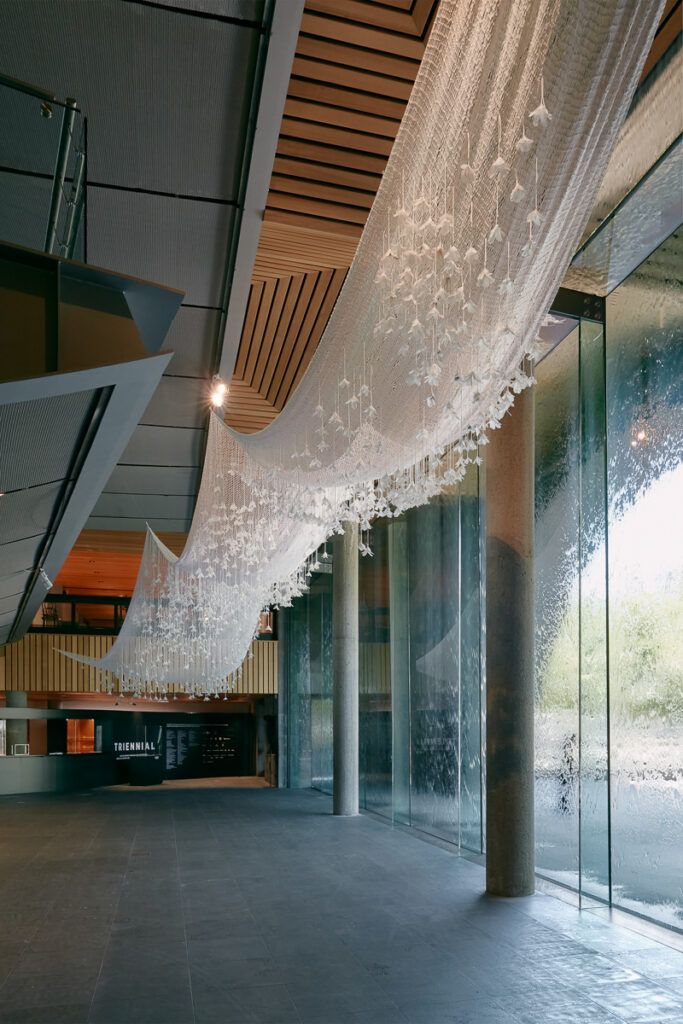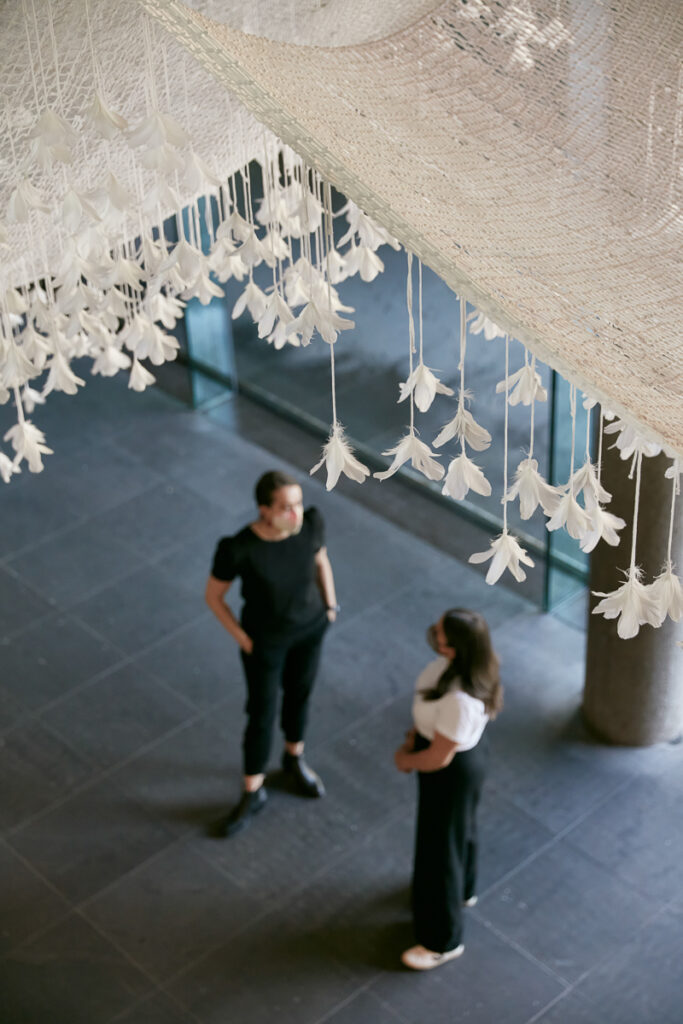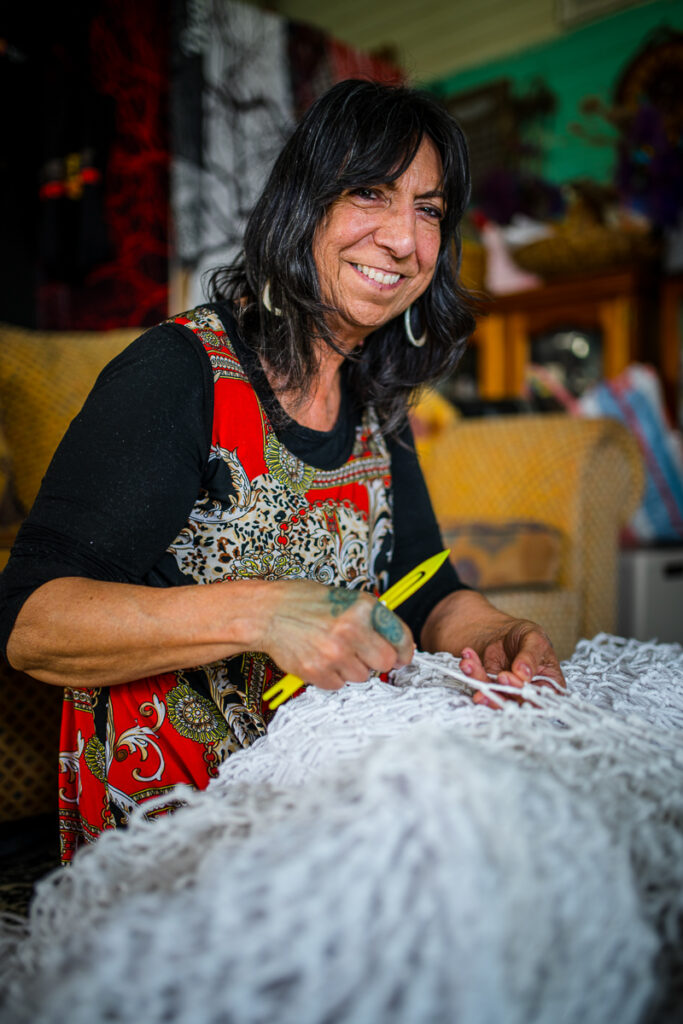- Installation view of Glenda Nicholls’s work Miwi Milloo (Good spirit of the Murray River) 2020 on display in NGV Triennial 2020 from 19 December 2020 – 18 April 2021 at NGV International, Melbourne © Glenda Nicholls. Photo: Tom Ross
- Installation view of Glenda Nicholls’s work Miwi Milloo (Good spirit of the Murray River) 2020 on display in NGV Triennial 2020 from 19 December 2020 – 18 April 2021 at NGV International, Melbourne © Glenda Nicholls. Photo: Tom Ross
- Installation view of Glenda Nicholls’s work Miwi Milloo (Good spirit of the Murray River) 2020 on display in NGV Triennial 2020 from 19 December 2020 – 18 April 2021 at NGV International, Melbourne © Glenda Nicholls. Photo: Tom Ross
Glenda Nicholls weaves fish nets and crafts feather flowers that continue a storyline passed down through her family around Milloo, otherwise known as the Murray River.
Glenda Nicholls was born in Wamba Wamba country in Swan Hill on the Murray River. Her Aboriginal name is Jule Yarra Minj, which means “Little River Girl”. Her ancestors are Wadi Wadi /Yorta Yorta and Ngarrindjeri. Her maternal totem is the Writcharuki (willy-willy wagtail), a totem of the great Ngarrindjeri nation.
In collaboration with NGV curator, Hannah Presley, she has produced an epic weaving for the Triennial titled, “MiWi Milloo” meaning, Good spirit of the Murray River. It is an approximately 16-metre long fish net adorned with hundreds of feather flowers made with the assistance of her daughter, Melinda Andrew. Glenda describes it as a collaboration with NGV curator Hannah Presley.
- Glenda Nicholls, photo: Wayne Quilliam
- Glenda Nicholls, photo: Wayne Quilliam
The work was made during the COVID pandemic in 2020. From February to October, Glenda spent 3-4 hours, sometimes more, a day weaving the net. “In all my projects, I start weaving when the project tells me to and I finish weaving the item when it tells me to stop.” The cotton used to weave the net was grown in Australia, but processed in China, luckily arriving just before shipping stopped due to Covid restrictions. And as she was weaving in a dusty environment, she had to weave the net into a doona cover to keep the net clean. With most outside activity curtailed, COVID gave her the space to work without distractions.
Glenda is quite open about the sourcing of her materials. The white duck feathers were sourced from feather.com.au and the weaving tools from Tackle World in Mackay QLD. While working with the feathers Glenda liked to think of the animals and pay them respect.
Glenda calls herself “a generational master weaver”. The craft of feather flowers has been passed down through generations. Each member of the family makes them in a different way. Originally made for ritual adornment, they became a source of income when needed to buy food during colonial settlement.
Fish nets were an essential part of life on the river. They were used to catch “otchika”, otherwise known as Murray Cod. Glenda describes how she learnt to make the nets.
I like crocheting and I love fishing. The particular technique for making the knots came to me in a dream. I discovered that this knot is used throughout the Murray River system and Roper River. I found similar knotted weaving when I attended the festival of Pacific Arts in Solomon Islands and Guam. In Guam, I met the traditional fishnet weaver and the process he used was very similar to mine.
Glenda does give weaving workshops, but says, “I’m careful who I show that process to. I don’t want the storyline exploited”. This “storyline” is the family traditional craft connection handed down through time. Her weaving is more than just a physical making process. It sustains a continuous thread that links generations.
Back a few of those generations, the father of her grandmother, Lady Gladys Nicholls, was born in India. Before COVID hit, Glenda was planning to travel to India for the first time. Let’s hope she does and may even make her first feather garland to complete one of the circles in her precious storyline.
You can visit Glenda Nicholls at www.glendanichollscreative.com.au.
✿








Comments
Dear Glenda, after seeing you Melbourne- I was wondering if I could organise with you to visit our – Melbourne Girls Grammar /South Yarra, one day during 2024. Please let me know..